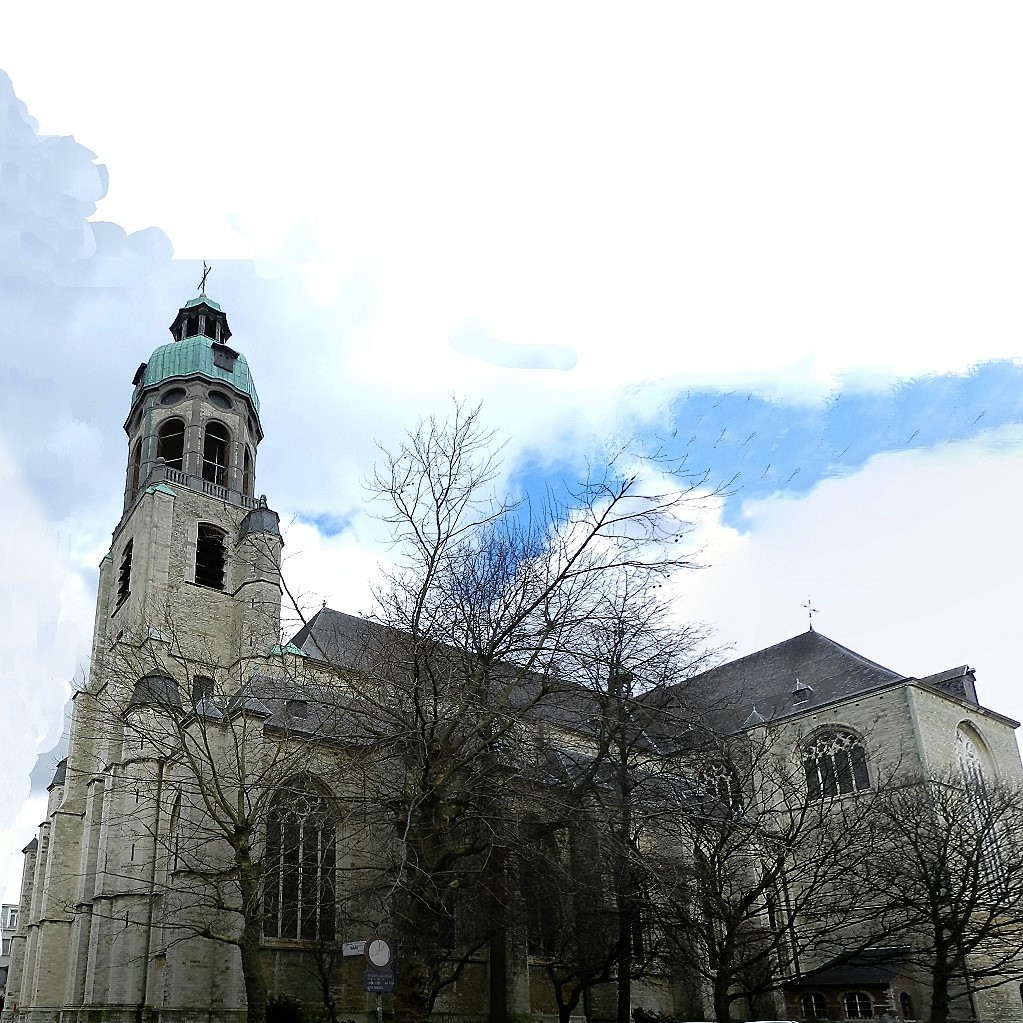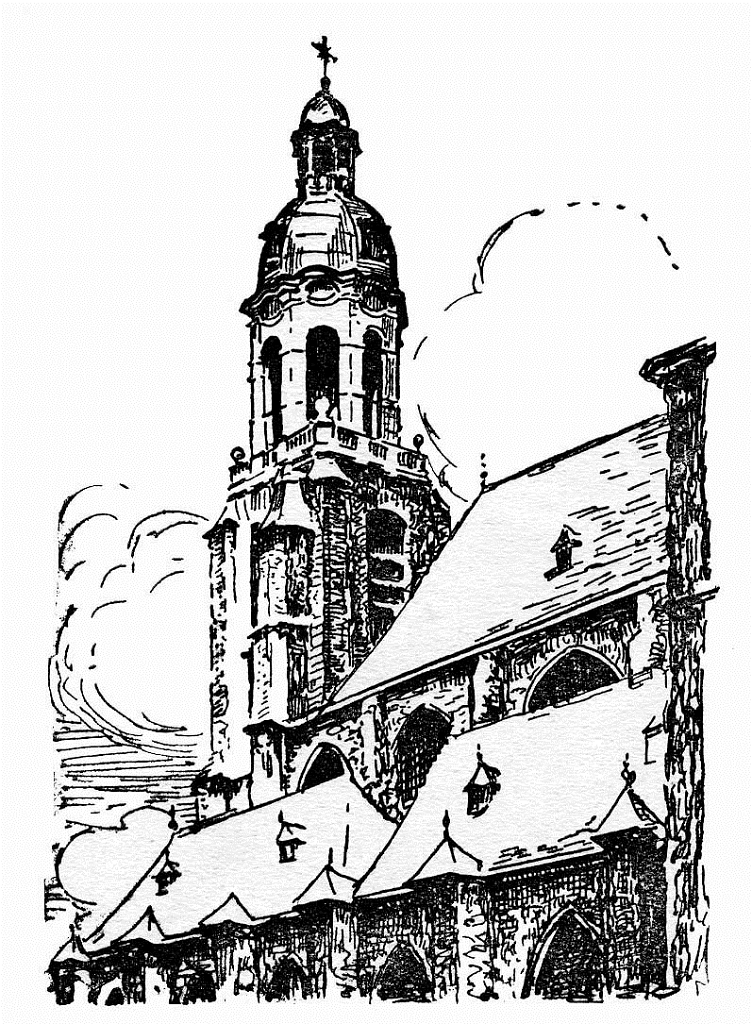Antwerp's St Andrew's Church, a revelation.
Introduction
The century-old parish church of St Andrew’s is situated next to the Kloosterstraat with its antique shops. On the church’s other side lies the Fashion Museum of the Nationalestraat, surrounded by an abundance of fashion stores. The church itself is filled with art works from the baroque period, and the fashionable dress of its Virgin Mary statue is unmistakeable.
Part of Old Antwerp’s most ‘folksy’ neighbourhood, the so-called Parish of Misery, St Andrew’s church and its emblematic tower playfully grace many a street view. With the towers of St Paul’s and the CathedralThe main church of a diocese, where the bishop’s seat is. of Our Lady, St Andrew’s tower determines the Antwerp skyline. (On old city panoramas, the church is hard to recognise. The current tower, in late baroque style, differs considerably from the church’s original tower, which collapsed in 1755.) It is hard to understand that this skyline has been being altered since 2001 by the ongoing, misguided construction of high-rise buildings on the banks of the Scheldt river.
Officially, the history of this parish church starts with its consecrationIn the Roman Catholic Church, the moment when, during the Eucharist, the bread and wine are transformed into the body and blood of Jesus, the so-called transubstantiation, by the pronouncement of the sacramental words. in 1529. Yet the church’s beginnings date back to the brief stay of the Augustine monks at the outset of the 16th century. As Lutheran sympathizers, the monks were expelled by the authorities. Subsequently, the church building was completed as a parish church with tower. In 1581, during the second “Iconoclastic Fury’, under the Calvinist Government, church choirIn a church with a cruciform floor plan, the part of the church that lies on the side of the nave opposite to the transept. The main altar is in the choir. and transeptThe transept forms, as it were, the crossbeam of the cruciform floor plan. The transept consists of two semi transepts, each of which protrudes from the nave on the left and right. were completely destroyed, along with the church’s sculptures. Only by the end of the 17th century, the church’s interior was entirely restored and expanded.
The parish territory of St Andrew’s was rather confined. During the 16th and 17th century, moreover, the art production of its rich inhabitants was often intended for the illustrious AbbeyA set of buildings used by monks or nuns. Only Cistercians, Benedictines, Norbertines and Trappists have abbeys. An abbey strives to be self-sufficient. of St Michael in the Kloosterstraat – a building which no longer exists today. During the 17th century, frequent commissions were given to the parish’s painters, among whom were a Francken descendant (Franckenstraat), Marten Pepijn, Erasmus and Jan Erasmus Quellinus. Although living at the parish of St Andrew’s for several years, Rubens was never given any such commission. By the time of the painter’s return from Italy to Antwerp in 1608, the church’s altars had already been upholstered by other ‘modern’ masters, such as Otto van Veen and Maerten de Vos.
With the help of an exceptionally ‘republican’ priestIn the Roman Catholic Church, the priest is an unmarried man ordained as a priest by the bishop, which gives him the right to administer the six other sacraments: baptism, confirmation, confession, Eucharist, marriage, and the anointing of the sick. who had sworn the oath of allegiance to the state, the church building and belongings survived the French Revolutionary Government. Following the 1801 Concordat and the abolishment of nearby monasteries, the church received a number of devotional pieces and art works. Among these were the relics of the 36 Saints, from the Abbey of Pieter Pot.
Extreme poverty peaked at the parish during the 19th century and the first half of the 20th century. At times, the number of parish inhabitants exceeded 35,000. This was when the parish earned its sobriquet as ‘parish of misery’.
Today, a small park adjacent to the church houses the statue of ‘Moeder Netje’ (Mother Nettie), the main character from the book ‘Moeder, waarom leven wij?’ This 1932 novel was written by Lode Zielens, born and raised in the shadow of St Andrew’s church. For centuries, Catholic faith provided the answer to the book’s philosophical title question – mother, why do we live? – for rich and poor alike. The building, decoration and refinement of the parish church still bear witness to this faith. In particular, celebrations by devotional fraternities contributed to the exuberance and rich decoration of the church’s interior up until the middle of the 20th century.
Today, depopulation, changed social circumstances and secularisation have rendered the community life of this city centre parish far from self-evident. The recent exodus from the city centre has effectively reduced the number of parish inhabitants to a tenth of former times. On the other hand, Christian inhabitants from Greater Antwerp choose to attend massThe liturgical celebration in which the Eucharist is central. It consists of two main parts: the Liturgy of the Word and the Liturgy of the Eucharist. The main parts of the Liturgy of the Word are the prayers for mercy, the Bible readings, and the homily. The Liturgy of the Eucharist begins with the offertory, whereby bread and wine are placed on the altar. This is followed by the Eucharistic Prayer, during which the praise of God is sung, and the consecration takes place. Fixed elements are also the praying of the Our Father and a wish for peace, and so one can symbolically sit down at the table with Jesus during Communion. Mass ends with a mission (the Latin missa, from which ‘Mass’ has been derived): the instruction to go out into the world in the same spirit. at the attractive church of St Andrew’s.
As the church’s transept and choir were only rebuilt after 1660, St Andrew’s remained conspicuously absent from 17th century panoramic paintings of church interiors. From the middle of the 18th century onwards, however, the church’s art objects began attracting the attention of popular art travel guides. Since the beginning of the 19th century, the new, dramatic pulpit has become the highlight of the church’s interior. Today, Otto van Veen’s Martyrdom of St Andrew and Artus I Quellinus’ work continue to draw visitors’ attention. Records show that the first ‘famous’ visitor came to St Andrew’s in 1886: a painting student named Vincent van Gogh. Possibly, the painter’s professors had encouraged van Gogh to visit the church and view their own works on display. During the 20th century, the playful patterns created by the fall of light inside the church have made St Andrew’s Antwerp’s church of choice for painters of church interiors.
Today, new art works and initiatives aim to relate Christian faith to contemporary creativity. This combination of new and old, ‘nova et vetera’ (Mt 13:52), has agreeably surprised audiences. Moreover, the outlook of the church’s interior thoroughly varies throughout the liturgical year. To discover all that the church of St Andrew’s has to offer, therefore, visitors do best to return!
Rudi Mannaerts, Antwerp, 2013


